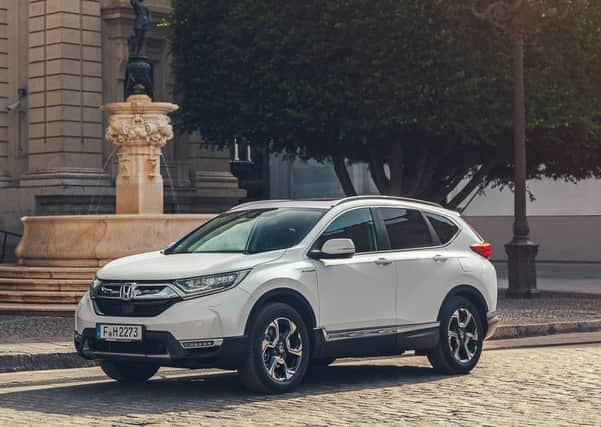Review: Honda CR-V Hybrid


The CR-V dates from 1995. For many years it was made at Honda’s factory in Swindon, Wiltshire, but that factory now makes only the Civic. It will close in 2021. Staff are campaigning to keep it open. We shall see.
Like all makers, Honda is turning towards electrification. In fact it started last century with the bespoke Insight project and subsequent hybrids have been niche sellers alongside mass market Jazz and Civic petrol cars.
Advertisement
Hide AdAdvertisement
Hide AdNow the electric future starts in earnest. “The CR-V hybrid is the first step in achieving our objective of electrified powertrains accounting for two-thirds of our European sales by 2025,” says Phil Webb, head of Honda UK’s car division.
Today’s CR-V is made in several countries. It is not only Honda’s best-seller but the world’s best-selling SUV. Ours comes from Japan. Tested here is the five-seater EX with all-wheel-drive. It costs £37,305 plus £550 for the rich grey metallic paint. You can have it in S, SE, SR specification too.
The front-wheel-drive S Hybrid is the price-entry tempter, at £29,105. The upgrade to SE is the next step, at £30,955 (or £32,065 with AWD). Useful kit is the rear camera, Garmin navigation and a touchscreen. However, the navigation graphics are old-fashioned, the screen is small and the responses can be tardy.
The SR (£33,445 and £34,545 with AWD) has leather, keyless entry and ignition, a screen de-icer, cornering lights, heated seats and alerts for lateral blind spots and crossing traffic. The EX has an opening glass roof, head up display, heated rear seats, heated steering wheel, powered tailgate and driver’s seat. All are on 18-inch alloys.
The other CR-V engine is a 1.5 petrol turbo delivering 171bhp with manual gears and uprated to 190bhp for the CVT automatic. Prices start at £25,995 for the S. There is a seven-seater with this engine, from £30,965 in SE grade.
The premium for the entry model Hybrid S over the 1.5 S is £3,110. It brings better fuel economy and better performance and tax benefits if you can offset it against a business or your income.
The hybrid basics are familiar. The car automatically switches between electric and petrol power. It will start off on electric and if there’s enough juice and the road is flat and the speed is modest there’s an emission-free range of a mile or two.
Mostly, it is running on petrol power with an electric input from the motors. The combination of power and torque from the engine and the motors makes it responsive, with economy rivalling a diesel.
Advertisement
Hide AdAdvertisement
Hide AdGears are selected by buttons: push D is forward. R is reverse – but the switch needs pulling up which prevents careless mishaps. N is neutral. P is park, plus an electric parking brake. It is all good. The ergonomics came adrift in other areas. The steering wheel is a confusion of buttons and switches. There are more controls scattered about the fascia. Moving around the screen menus is not intuitive and, admittedly a beginner, I had to start again on some functions.
There is the usual display of symbols denoting how green is your progress, including a scale showing whether the electric motor battery is being recharged, or is boosting the petrol engine. There is a Sport setting if you want to forgo some economy.
So, off we go. The direct-drive power train is smooth and quiet. Hybrids are heavier and while the extra muscle compensates, they are not as nimble on curves. Honda has put a lot of work into the new chassis. The stability system has been set for European roads – rather a broad-brush method to deal with a huge variety of surfaces. My immediate opinion was it suffered from excessive road noises.
The ride comfort is good, with the 235/60 section tyres absorbing lumps and holes. It is an SUV, so some rough-roading is possible. The ground clearance is 192mm or 7.5 inches on the AWD model. However, the braked towing weight is rated at just 600kg – compared with a horse-trailer friendly 2000kg with the 1.5 engine.
The cabin is now roomy: it measures 58 inches across the cabin.
The load area, even with the seats in place, is generous and seats fold away easily to take longer loads.
The exterior is bolder, with Honda styling signatures and rather a lot of rear chrome which is familiar on these rather flashy SUVs.
Verdict: Good mix of economy and performance.